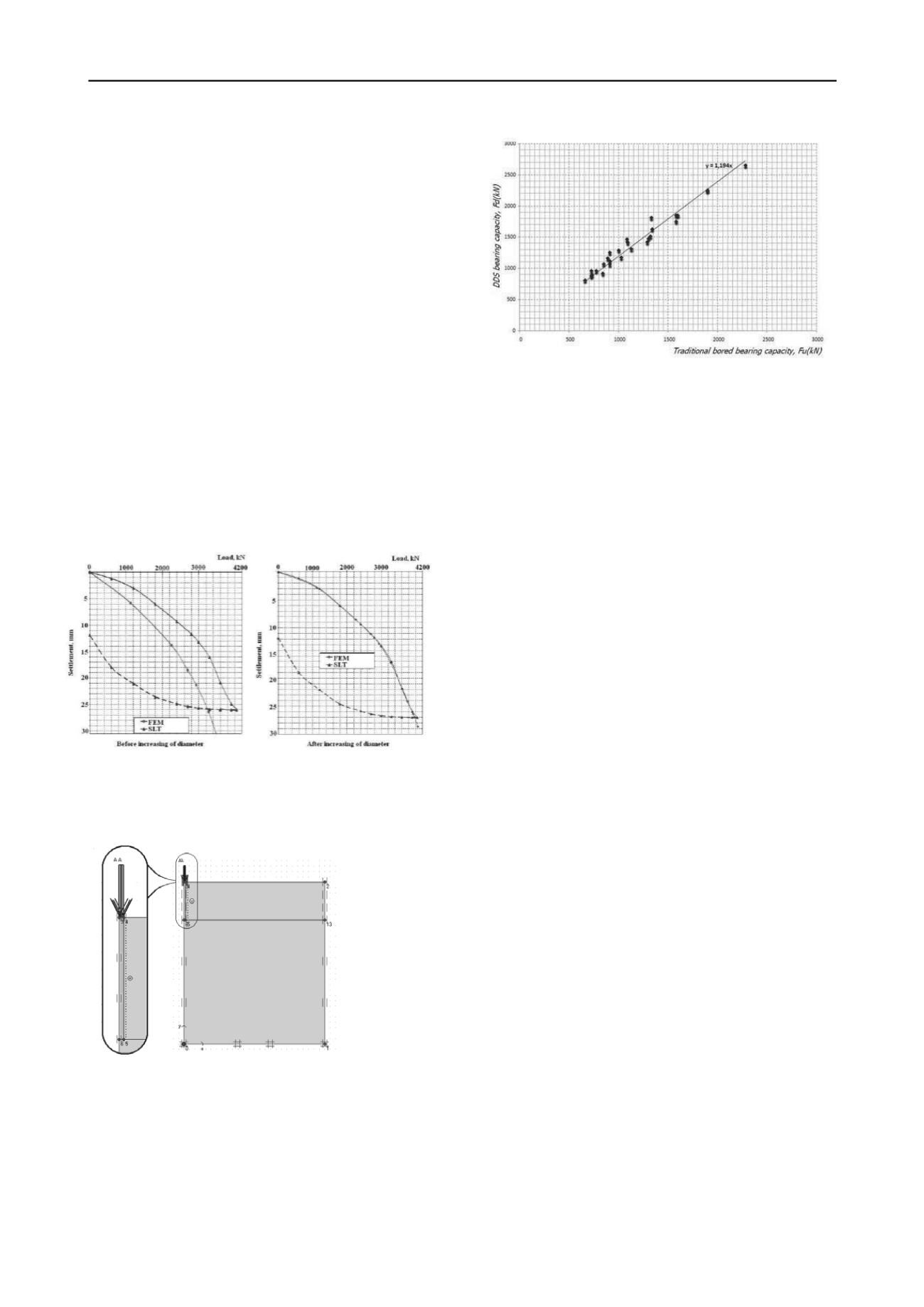
3152
Proceedings of the 18
th
International Conference on Soil Mechanics and Geotechnical Engineering, Paris 2013
5 FEM MODELING OF BORED PILES
CFA Boring pile technology
. The FEM elasto-plastic analysis
was provided by computer program established by Prof.
Tadatsugu Tanaka. It was used the mechanical properties of soil
ground for the numerical calculation of bearing capacity and
settlement. For analyzing bearing capacity of working as
friction CFA and Casing piles were modeled and compared with
results of static load test.
Taking advantage of the axi-symmetric nature of the
problem, only a half domain of the model ground and pile were
analyzed. The soil ground and pile were discredited into four
noded quadrilateral elements. Number of nodal points are 675,
number of finite elements are 606, number of materials are 4
(1is sand with gravel, 2 is hard clay, 3 is clay, 4 is bored pile).
Figure 8. Comparison diagram
During CFA pile installation the question of over-
expenditure of concrete was appeared. The actual volume of
borehole was about 1.3-1.4 times more than theoretical volume
of borehole (Ashkey Y. 2008). After determination of
preliminary average radius (r+
r) increasing diameter of CFA
piles and remodeled numerical mesh FEM analysis was
repeated. It gives us increasing bearing capacity of CFA piles
respectively “load-settlement” results of field static load test and
stress and strain of soil around of single CFA pile through FEM
computer program. The results of “load-settlement” through
FEM illustrated in Figure 6.
6 CONCLUSIONS
There were presented very short descriptions of geoengineering
approach to the installation, testing and quality control of pile
foundation which using on construction sites of Kazakhstan.
This experience probable lead to the coming changes of the
concept of Kazakhstan pile foundation design.
During designing of CFA pile of buildings and structures is
need to consider volume of borehole expansion by result of
additional pressure, as well as over-expenditure of the concrete
which is depend on soil conditions and length of pile.
Significant differences between bearing capacities of DDS and
casing boring piles show incomplete usage of DDS technology
resources. The coefficient of shaft work of DDS pile was
defined and equal from 1.2 to 1.3 depending on soil condition.
PDA allows tests up to 10 piles per day, much cost effective
than SLT, and more authentic than DLT. PDA is a type of DLT
and is appropriate for any type of pile, but cannot be used to full
extent on construction sites of Kazakhstan due to absence of
Standard.
Figure 6. Results of CFA FEM analysis
DDS Boring pile technology
. The FEM modeling of DDS
pile was made in Plaxis 2D computer program (Figure 7).
Pile integrity test is in the process of gaining official
acceptance in Kazakhstan. PIT is a non-destructive method
allowing make quality control of pile body whereupon of pile
installation and even after many years of building exploitation.
Geomonitoring for foundation settlement is indirect control of
pile quality evaluation method and has become more relevant,
especially for high-rise building construction.
Application of advanced technologies of pile foundations
installation led to a significant economical efficiency.
According to tests results, the piles installed by the above
technologies showed high values of bearing capacity, which led
to a decrease of pile length by 10 to 20% and increase
economical efficiency by 20 to 30%.
7 REFERENCES
Zhussupbekov A.Zh. and Lukpanov R.E. 2012, Geotechnical issues of
megaprojects on problematical soil in Kazakhstan
, Volume of
Abstracts of ACEM`12,
Seoul, Korea, 127.
Sultanov G.A., Zhussupbekov A.Zh. Lukpanov R.E. and Enkebaev S.B.
2010, Research of Interaction between Displacement Pile and Soil
Basement.
Proc. of Kaz-Kor joint geotechnical seminar
. Astana,
Kazakhstan, 84-91.
Figure 7. FEM modeling of DDS
The comparison diagram of bearing capacities of DDS and
traditional bored piles by Plaxis is presented in Figure 8
(Expressed by k=F
d
/F
u
, where F
d
– DDS bearing capacity, F
u
–
traditional bored pile bearing capacity). The points on diagram
are lying above the diagonal line; it means that the values of
DDS bearing capacity are exceeding traditional bored piles [2].
Ashkey Y. 2008, Interaction of CFA bored piles with soil condition in
Astana.
A dissertation submitted in partial fulfillment of the
requirements for the PhD degree.
Astana, Kazakhstan.
SNiP RK 5.01-03-2002 “Pile foundation”.
Zhussupbekov A.Zh. and Lukpanov R.E. 2012, Geotechnical issues of
megaprojects on problematical soil in Kazakhstan
, Proc. of 3
rd
ICNDSMGE-ZM 2012,
Near East University, Nicosia, TRNC,
67-75.
After some transformation it was got FEM coefficient of
DDS pile works, which vary from 1.23 – 1.35 depends on type
of soil (See Table 1).


